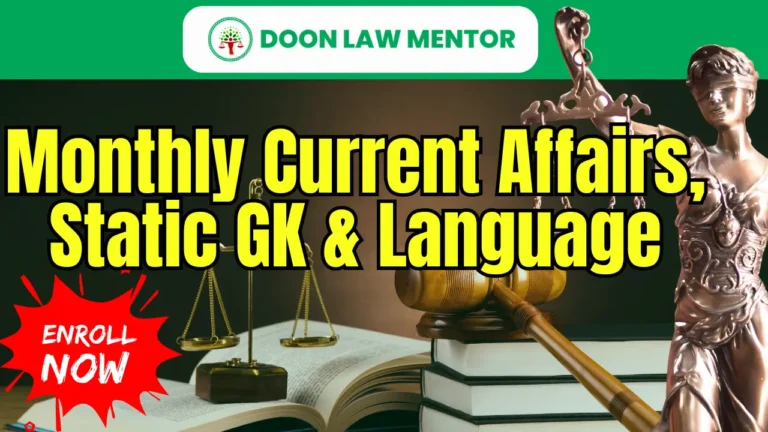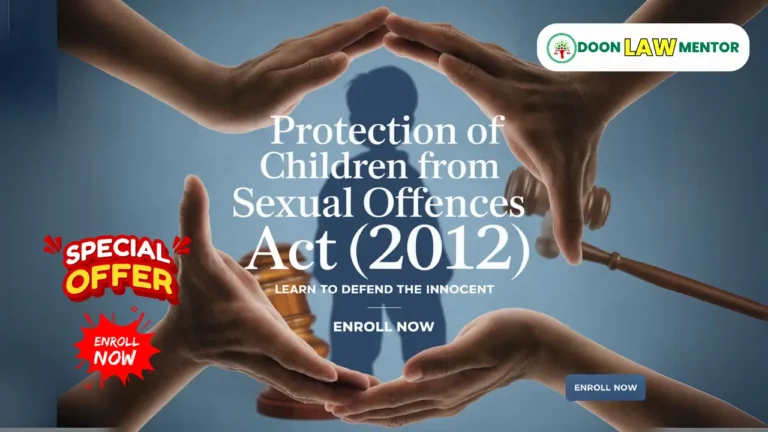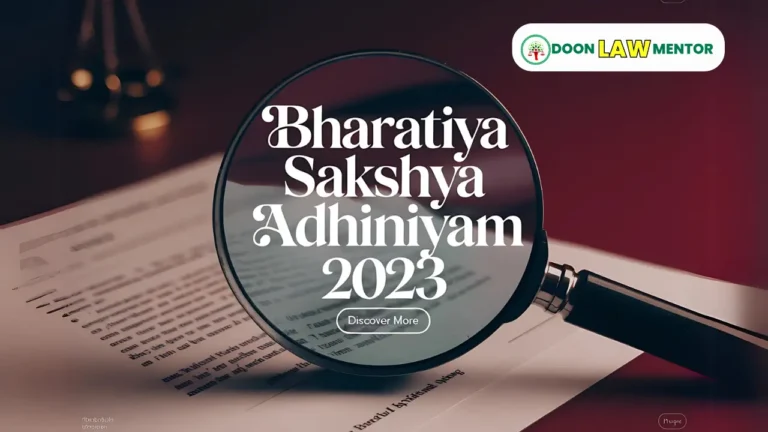In Munnesh v. State of UP (2025 SC), the Supreme Court issued new guidelines on bail and anticipatory bail, mandating petitioners to disclose their criminal antecedents in the petition synopsis. Justices Dipankar Datta and Manmohan warned that false disclosures could lead to petition dismissal, addressing the issue of non-disclosure that often misleads courts. This blog explores the Supreme Court guidelines on bail, their implications, and their relevance for Judiciary, APO, and JLO aspirants preparing for 2025 exams.
Table of Contents
The Supreme Court of India issued groundbreaking guidelines on bail and anticipatory bail in the case of Munnesh v. State of UP (2025 SC), mandating that petitioners seeking bail must disclose their criminal antecedents in the petition synopsis. Justices Dipankar Datta and Manmohan emphasized the need for transparency, warning that false disclosures could lead to the dismissal of petitions. The ruling addresses a long-standing issue where petitioners often concealed their criminal history, misleading courts and delaying justice. This blog provides a detailed analysis of the Supreme Court guidelines on bail, their legal implications, and their significance for Judiciary, APO, and JLO aspirants preparing for 2025 exams.
Background of Munnesh v. State of UP (2025 SC)
The case of Munnesh v. State of UP (2025 SC) arose from a Special Leave Petition (SLP) challenging a lower court’s decision to deny regular bail or anticipatory bail to the petitioner, Munnesh. During the proceedings, the Supreme Court bench, comprising Justices Dipankar Datta and Manmohan, noted a recurring issue: petitioners often failed to disclose their criminal antecedents, leading to courts being “taken on a ride.” This lack of transparency resulted in notices being issued, only for the State or respondents to later reveal the petitioner’s criminal history, wasting judicial time and resources.
Previous Leniency and Failed Directions
- The Supreme Court acknowledged its past leniency in such cases, often overlooking non-disclosure to ensure fairness.
- Earlier directions in Kulwinder Singh v. State of Punjab (2023) and Sheikh Bhola v. State of Bihar (2023) aimed to elicit correct information from bail petitioners but failed to produce the desired results, as petitioners continued to withhold critical details.
- Frustrated by this trend, the court decided to enforce stricter measures to prevent the abuse of the legal process.
Court’s Observations
- The bench highlighted that non-disclosure of criminal antecedents undermines the integrity of judicial proceedings, stating: “This Court has shown leniency in the past, but we think it is time that such state of affairs is not allowed to continue further.”
- The court emphasized the need to protect the institutional interest of the judiciary, ensuring that proceedings are not taken lightly by those who approach the court.
Key Features of the Supreme Court Guidelines on Bail and Anticipatory Bail
In Munnesh v. State of UP (2025 SC), the Supreme Court issued the following guidelines on bail and anticipatory bail, effective immediately for all future petitions:
1. Mandatory Disclosure of Criminal Antecedents
- Petitioners seeking regular bail (under Sections 439 of the CrPC or Section 483 of the Bharatiya Nagarik Suraksha Sanhita, BNSS)) or anticipatory bail (under Sections 438 of the CrPC or Section 482 of the BNSS) must mandatorily disclose their criminal antecedents in their Special Leave Petitions (SLPs) filed before the Supreme Court.
- The synopsis of the petition must explicitly state:
- Whether the petitioner has clean antecedents (i.e., no involvement in any criminal case).
- If involved in any criminal case, the petitioner must provide specific details, including the stage of proceedings (e.g., investigation, trial, appeal, or conviction).
- Consequence of False Disclosure: If the disclosure is found to be incorrect or false, the Supreme Court warned that this could be a ground for dismissal of the petition, ensuring accountability and transparency.
2. Scope of Application
- The guidelines apply to SLPs (Criminal) challenging orders passed by High Courts or Sessions Courts that decline bail under:
- Section 438 CrPC/Section 482 BNSS (anticipatory bail).
- Section 439 CrPC/Section 483 BNSS (regular bail).
- The Bharatiya Nagarik Suraksha Sanhita (BNSS), which replaced the CrPC on July 1, 2024, is referenced alongside the CrPC, as cases may involve proceedings under either law depending on the timeline of the case.
3. Institutional Interest and Prevention of Abuse
- The court issued these guidelines to protect the institutional interest of the judiciary, stating: “We have proceeded to make the aforesaid direction in the institutional interest so that proceedings before this Court are not taken lightly by those who choose to approach it and the process of law is not abused.”
- The court noted that non-disclosure often leads to misleading judicial proceedings, where notices are issued based on incomplete information, only for the State to later reveal the petitioner’s criminal history.
4. Acknowledgment of Inconvenience
- The Supreme Court acknowledged that the new guidelines might cause inconvenience to some petitioners, particularly those with complex legal histories or genuine oversight.
- However, the court justified the directive by citing the failure of previous guidelines in Kulwinder Singh v. State of Punjab (2023) and Sheikh Bhola v. State of Bihar (2023) to ensure transparency, necessitating stricter measures.
5. Directive to the Supreme Court Registry
- The court directed the Supreme Court Registry to circulate these guidelines to all relevant stakeholders, ensuring that advocates, petitioners, and lower courts are aware of the new requirements.
- This step aims to standardize the disclosure process across all SLPs (Criminal) filed before the Supreme Court.
Legal Implications of the Supreme Court Guidelines
The Supreme Court guidelines on bail in Munnesh v. State of UP (2025 SC) have far-reaching implications for bail proceedings, judicial transparency, and legal accountability:
1. Enhanced Transparency in Bail Proceedings
- The mandatory disclosure of criminal antecedents ensures that courts have a complete picture of the petitioner’s legal history before deciding on bail or anticipatory bail, aligning with the principles of natural justice and due process.
- This addresses a long-standing issue highlighted in cases like Satender Kumar Antil v. Central Bureau of Investigation (2022), where the Supreme Court emphasized balancing the rights of the accused with the interests of justice in bail matters.
- By requiring petitioners to disclose their involvement in criminal cases and the stage of proceedings, the court aims to prevent misrepresentation and ensure informed judicial decisions.
2. Deterrence Against False Disclosures
- The warning that false disclosures could lead to petition dismissal acts as a deterrent against petitioners concealing their criminal history, promoting honesty in legal proceedings.
- This aligns with the Supreme Court’s broader jurisprudence on judicial integrity, as seen in Gurbaksh Singh Sibbia v. State of Punjab (1980), where the court held that anticipatory bail should be granted based on reasonable grounds and not misused to evade justice.
- The guideline ensures that petitioners cannot exploit the bail process to delay or obstruct investigations, a concern raised in Srikant Upadhyay v. State of Bihar (2024), where the court cautioned against granting interim protection that could hinder investigations.
3. Impact on Judicial Efficiency
- The court’s observation that non-disclosure leads to courts being “taken on a ride” highlights the judicial inefficiency caused by incomplete information.
- By mandating upfront disclosure, the guidelines reduce the need for additional hearings to uncover hidden facts, saving judicial time and resources, a principle echoed in Satender Kumar Antil (2022), which set timelines for disposing of bail applications (two weeks for regular bail, six weeks for anticipatory bail).
- This also prevents the issuance of unnecessary notices, streamlining the bail adjudication process.
4. Balancing Rights and Responsibilities
- The guidelines balance the right to liberty under Article 21 of the Constitution with the responsibility of petitioners to be transparent, ensuring that the bail process is not abused.
- In Bhadresh Bipinbhai Sheth v. State of Gujarat (2015), the Supreme Court held that anticipatory bail is rooted in Article 21 (right to personal liberty), but the court in Munnesh v. State of UP clarifies that this right comes with the duty to provide accurate information.
- The ruling reinforces the court’s stance in Savitri Agarwal v. State of Maharashtra (2009), where it emphasized that petitioners must have a reasonable belief of arrest, backed by specific facts, to seek anticipatory bail.
5. Institutional Integrity and Public Trust
- The court’s focus on institutional interest underscores the need to maintain public trust in the judiciary, ensuring that the legal process is not manipulated by petitioners with hidden criminal histories.
- This aligns with the Supreme Court’s observations in Subrata Roy Sahara v. Pramod Kumar Saini (2022), where it ruled that inquiries in anticipatory bail applications should be limited to the applicant’s case, avoiding misuse of the process.
- The directive to the Supreme Court Registry to circulate the guidelines ensures widespread awareness, promoting uniform application across all SLPs (Criminal).
Critical Analysis: A Step Toward Transparency or a Barrier to Justice?
The Supreme Court guidelines on bail in Munnesh v. State of UP (2025 SC) aim to enhance transparency, but they also raise several questions about their practical implications and potential challenges.
Strengths
- Promotes Transparency: The mandatory disclosure of criminal antecedents ensures that courts make informed decisions, reducing the risk of granting bail to habitual offenders who conceal their history, a concern raised in Satender Kumar Antil (2022).
- Prevents Abuse of Process: The threat of petition dismissal for false disclosures deters petitioners from misleading the court, aligning with the Supreme Court’s stance in Srikant Upadhyay v. State of Bihar (2024) that interim protection should not obstruct investigations.
- Judicial Efficiency: By requiring upfront disclosure, the guidelines minimize judicial delays caused by incomplete information, supporting the court’s push for timely disposal of bail applications as seen in Satender Kumar Antil (2022).
- Institutional Integrity: The focus on institutional interest protects the judiciary’s credibility, ensuring that the bail process is not exploited, a principle echoed in Gurbaksh Singh Sibbia v. State of Punjab (1980), which cautioned against blanket anticipatory bail orders.
Challenges and Concerns
- Potential Inconvenience: The court acknowledged that the guidelines might cause inconvenience to some petitioners, particularly those with complex legal histories or genuine oversight, as noted in the judgment. For example, petitioners with minor or unrelated past cases may face delays or rejections due to procedural errors in disclosure.
- Risk of Overreach: Critics argue that the strict penalty of petition dismissal for false disclosures could disproportionately affect first-time offenders or those unaware of their legal obligations, potentially infringing on their right to liberty under Article 21. This concern echoes the Supreme Court’s caution in Bhadresh Bipinbhai Sheth v. State of Gujarat (2015) that anticipatory bail provisions should be interpreted broadly to protect personal liberty.
- Implementation Challenges: The guidelines rely on petitioners’ self-disclosure, which may be incomplete or inaccurate due to lack of legal awareness, especially among economically disadvantaged petitioners. Posts on X reflect mixed sentiment, with some users praising the move for curbing abuse of bail, while others worry it may “burden genuine petitioners” with additional procedural hurdles.
- Judicial Discretion: While the guidelines aim to standardize disclosure, they may limit judicial discretion in cases where non-disclosure is unintentional. The Supreme Court’s earlier ruling in M.C. Abraham v. State of Maharashtra (2003) held that rejection of anticipatory bail does not mandate arrest, suggesting courts should retain flexibility to assess each case on its merits.
Critical Perspective
The Supreme Court guidelines on bail are a necessary step to address the systemic issue of non-disclosure, which undermines judicial integrity and delays justice. However, the strict enforcement of petition dismissal for false disclosures raises concerns about access to justice, particularly for marginalized petitioners who may lack legal literacy or resources to ensure accurate disclosure. The Supreme Court’s acknowledgment of inconvenience suggests a potential for unintended consequences, such as discouraging genuine petitioners from seeking bail due to fear of procedural errors. Moreover, the guidelines do not address the root cause of non-disclosure—such as inadequate legal aid or awareness—highlighted in Moti Ram v. State of MP (1978), where the court emphasized the need to lower bail burdens for the poor. A more balanced approach might involve legal education initiatives alongside these guidelines to ensure equitable access to justice, rather than relying solely on punitive measures.
Relevance for Judiciary, APO, and JLO Aspirants
The Supreme Court guidelines on bail in Munnesh v. State of UP (2025 SC) are a critical topic for Judiciary, APO, and JLO aspirants preparing for 2025 exams:
- Prelims: Expect questions on the case name (Munnesh v. State of UP), the mandatory disclosure requirement, the consequence of false disclosures (petition dismissal), and the relevant legal provisions (Sections 438/439 CrPC, Sections 482/483 BNSS).
- Mains: Write essays on topics like “Supreme Court Guidelines on Bail: Balancing Transparency and Access to Justice” or “Impact of Criminal Antecedents Disclosure on Bail Proceedings,” discussing Article 21, judicial efficiency, and legal accountability, with references to Satender Kumar Antil (2022), Gurbaksh Singh Sibbia (1980), and Bhadresh Bipinbhai Sheth (2015).
- Interviews: Discuss the implications of the guidelines for judicial transparency, access to justice, and institutional integrity, citing Munnesh v. State of UP and related cases, while addressing potential challenges for marginalized petitioners.
Conclusion
The Supreme Court guidelines on bail and anticipatory bail, issued on April 4, 2025, in Munnesh v. State of UP (2025 SC), mark a significant step toward enhancing transparency and accountability in bail proceedings. By mandating the disclosure of criminal antecedents in the petition synopsis and warning of petition dismissal for false disclosures, Justices Dipankar Datta and Manmohan addressed the systemic issue of non-disclosure that often misleads courts. The guidelines build on precedents like Satender Kumar Antil (2022) and Gurbaksh Singh Sibbia (1980), emphasizing the balance between personal liberty under Article 21 and the institutional interest of the judiciary. For Judiciary, APO, and JLO aspirants, understanding these guidelines is essential for 2025 exams, offering insights into bail law, judicial transparency, and legal reforms, and preparing them to tackle questions on these topics with a nuanced perspective.
Call-to-Action
Master the Supreme Court guidelines on bail for your 2025 exams! Join Doon Law Mentor’s Courses for expert guidance. Follow @doonlawmentor on Instagram for daily legal updates!
FAQs
- What did the Supreme Court rule in Munnesh v. State of UP (2025 SC)?
The Supreme Court mandated that petitioners seeking regular bail or anticipatory bail must disclose their criminal antecedents in the petition synopsis, with false disclosures leading to petition dismissal. - What are the Supreme Court guidelines on bail issued in 2025?
The guidelines require mandatory disclosure of criminal antecedents in the synopsis of SLPs (Criminal), specifying if the petitioner has clean antecedents or details of any criminal case involvement. - What happens if a petitioner makes a false disclosure in a bail petition?
If a petitioner’s disclosure of criminal antecedents is found to be false, the Supreme Court warned that the petition could be dismissed. - Which legal provisions are covered by the Supreme Court guidelines on bail?
The guidelines apply to Sections 438/439 CrPC (or Sections 482/483 BNSS) for anticipatory and regular bail petitions. - Why did the Supreme Court issue these guidelines in Munnesh v. State of UP?
The court noted that non-disclosure of criminal antecedents often misled courts, wasting judicial time, as revealed by the State or respondents after notices were issued. - What was the Supreme Court’s stance on past leniency in bail cases?
The court stated, “This Court has shown leniency in the past, but we think it is time that such state of affairs is not allowed to continue further,” emphasizing stricter measures. - How do the guidelines protect institutional interest?
The guidelines ensure judicial transparency by preventing petitioners from concealing criminal history, protecting the institutional interest of the judiciary from abuse of process. - What previous cases influenced the Supreme Court guidelines on bail?
The guidelines build on Kulwinder Singh v. State of Punjab (2023) and Sheikh Bhola v. State of Bihar (2023), which failed to ensure transparency in bail disclosures. - How do the guidelines impact judicial efficiency?
By mandating upfront disclosure, the guidelines reduce judicial delays caused by incomplete information, minimizing unnecessary notices and hearings. - Why are the Supreme Court guidelines on bail important for Judiciary aspirants?
The guidelines address bail law, judicial transparency, and legal accountability, making them a key topic for prelims, mains, and interviews in 2025 exams.
#SupremeCourtGuidelines, #BailGuidelines2025, #MunneshCase, #JudiciaryExams #munneshvsstateofup







